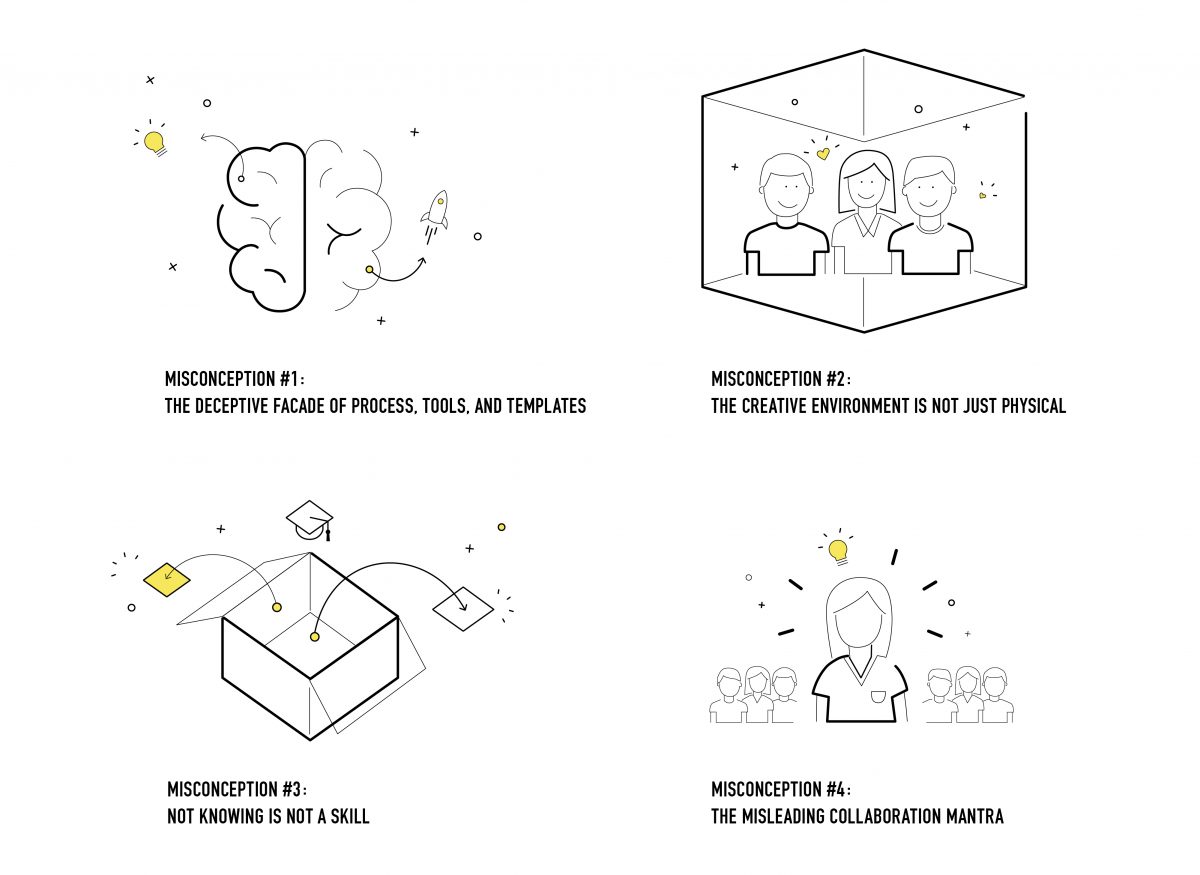Point of View
A SUBJECT with many misconceptions
TIME TO GET SERIOUSLY SERIOUS ABOUT CREATIVITY
In a world facing increasingly complex challenges, creativity is seen as the number one go-to force for positive change. While often described as a basic human trade, creativity still needs to be continuously trained and stimulated, just like a muscle. So to address today’s multidimensional challenges, we should be well prepared and bring the most possible expertise and experience to the table.
We want to share some of the main misconceptions underlying a ”creativity light” approach and to offer solutions on how to address the issue from a more in-depth perspective.
THE four misconceptions of creativity
Do you want to boost creativity in your team?
We show you how to better leverage creativity for the benefit of your whole organization.
Get in touch!
MISCONCEPTION #1:
THE DECEPTIVE FACADE OF PROCESS, TOOLS, AND TEMPLATES
Each and every of the “creativity light” providers flaunts their version of a creative process chart, their set of creativity tools, and their – totally proprietary – set of templates that will help you to use the tools and get through the process.
Let us say this right away: creativity is in many ways the opposite of all those three. It is – at its core – about the absence of process: We all know the clichés of having great ideas in the shower while exercising, or even when we sleep.
Those clichés are right on target! They illustrate a scientific fact: our brain needs to switch back and forth from focus to distraction to be able to make uncommon connections.
THERE IS NO EASY PEASY RECIPE FOR CREATIVITY!
A better way:
- Instead of a one-fits-all approach, do a creativity audit in your organization! Where are your weak points? What can you address in-house, where do you need help?
- No creativity without trust: Take a people-over-process approach!
- Whatever the process – always build in time for spontaneity!
MISCONCEPTION #2:
THE CREATIVE ENVIRONMENT IS NOT JUST PHYSICAL
We all know the images: Post-it® notes abound, some casual furniture, and one of those grown-up toys: a foosball table, table tennis, or a dartboard. While casual, non-intimidating environments are surely one first step to set the stage for creative activity, it is the social environment and not the physical that will make all the difference. To be creative in an organization, one thing is most important: psychological safety, the shared belief that the group is safe for interpersonal risk-taking.
This means safety from unfair judgment, ridicule, or even isolation. Don’t just take it from us, but listen to Amy Edmondson, Harvard professor and author of The Fearless Organization: Creating Psychological Safety in the Workplace for Learning, Innovation, and Growth – it’s right there in the title!
PSYCHOLOGICAL SAFETY GOES WAY BEYOND THE PHYSICAL!
A better way:
- Spend some of that budget for fancy furniture on team building.
- Create a safe place for ideas – even the quirky ones – by only sharing results and not intermediate steps.
- Instead of showing off the creative space, make it a top-secret zone for creative development!
MISCONCEPTION #3:
NOT KNOWING IS NOT A SKILL
“Thinking outside of the box” is often the go-to description when we talk about creativity. It is a great metaphor for the process of making formerly unseen connections to solve a problem at hand – the very definition of being creative. However, the meaning of the phrase is being more and more morphed to describe “having an outside perspective”. And this, in turn, has led to the conclusion, that people who are new to the matters at hand might be better equipped to innovate. While a fresh perspective is definitely an asset – fresh here too often means uninformed instead of just different. The gospel of “a certain amount of naivety” being the shortcut to innovation will in most cases lead to frustrations in the long run.
TO THINK OUTSIDE OF THE BOX YOU HAVE TO KNOW THE BOX!
A better way:
- Always bring the relevant technical expertise to the table – especially if you want to challenge the status quo.
- Create an exchange at eye level: Have non-engineers understand technology – and engineers understand the human experience.
- Don’t make feasibility the last thing to address!
MISCONCEPTION #4:
THE MISLEADING COLLABORATION MANTRA
The myth of the open-plan office as a creative engine has been debunked by many studies, yet the emphasis on the need for teamwork to be creative seems to be stronger than ever.
To us that has always been surprising: yes, the right team can help to inspire and to test ideas but for us, nothing beats some quality alone-time to really think challenges through before sharing it with a greater audience. In our careers, we have also found that there is a strong cultural component when it comes to working creatively in teams.
Different cultures have different approaches to hierarchy, individualism, and risk-taking – all issues that can have a huge impact on the psychological safety of a group.
WHO SAYS YOU CANNOT BE CREATIVE BY YOURSELF?
A better way:
- Create an environment for extroverts and introverts
- Be sensitive to cultural diversity
- Realize that productivity and attendance are not related

If you want to profit from true creativity, work with us!
Meanwhile, you can download our booklet and our creativity poster to spread the word:
Time to get seriously serious about creativity


